4-stroke tilt and motion
since December 5, 2012
The 4-stroke tilt illusion of the mixed type (supposing e.g. the Café Wall illusion)

The horizontally aligned border of the upper and lower halves appears to
tilt counterclockwise.
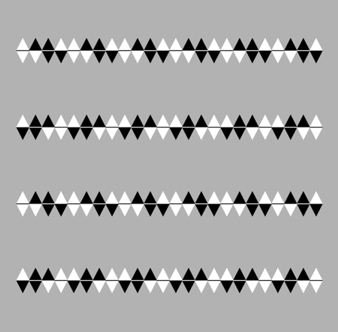
The horizontally aligned border of the uppermost row appear to tilt counterclockwise, and the other borders appear to tilt alternately.
The 4-stroke motion of the mixed type (Takeuchi's four-stroke motion)
Takeuchi, T. (1997) The motion analogue of the cafe wall illusion. Perception, 26, 569-584.
The border appears to move upward.
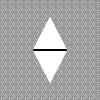
(GIF animation)

The movie shows elements in the order 123412341234...
Copyright Akiyoshi Kitaoka 2012 (December 4)
Café Wall illusion
The horizontal gray line appears to tilt counterclockwise (Fraser, 1908;
Gregory and Heard, 1979; Münsternerg, 1897).

Fraser, J. (1908) A new visual illusion of direction. British Journal of Psychology, 2, 307-320.
Gregory, R. L. and Heard, P. (1979) Border locking and the Café Wall illusion. Perception, 8, 365-380.
Münsterberg, H. (1897) Die vershobene Schachbrettfigur. Zeitschrift für Psychologie, 15, 184-188.
The 4-stroke tilt illusion of the line type (illusion of shifted lines)

The horizontally aligned border of the upper and lower halves appears to
tilt counterclockwise.
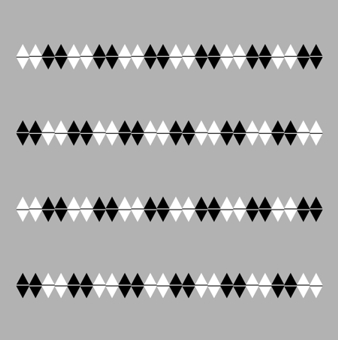
The horizontally aligned border of the uppermost row appear to tilt counterclockwise, and the other borders appear to tilt alternately.
The 4-stroke motion of the line type
Mather, G. and Murdoch, L. (1999) Second-order processing of four-stroke apparent motion. Vision Research, 39, 1795-1802.
http://www.georgemather.com/MotionDemos/FourstrokeQT.html
The border appears to move upward.
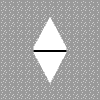
(GIF animation)

The movie shows elements in the order 123412341234...
Copyright Akiyoshi Kitaoka 2012 (December 4)
illusion of shifted lines
The horizontal black-and-white line appears to tilt counterclockwise (Kitaoka,
2007).

Kitaoka, A. (2007) Tilt illusions after Oyama (1960): A review. Japanese Psychological Research, 49, 7-19. PDF
The 4-stroke tilt illusion of the line type (illusion of shifted edges)

The horizontally aligned border of the upper and lower halves appears to
tilt counterclockwise.
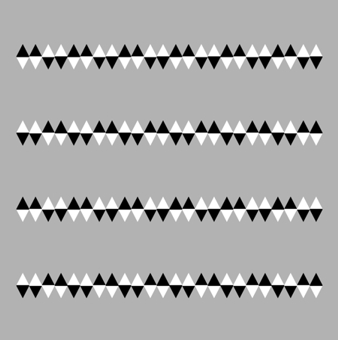
The horizontally aligned border of the uppermost row appear to tilt counterclockwise, and the other borders appear to tilt alternately.
The 4-stroke motion of the edge type
Mather, G. and Murdoch, L. (1999) Second-order processing of four-stroke apparent motion. Vision Research, 39, 1795-1802.
http://www.georgemather.com/MotionDemos/FourstrokeQT.html
The border appears to move upward.
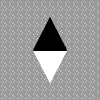
(GIF animation)

The movie shows elements in the order 123412341234...
Copyright Akiyoshi Kitaoka 2012 (December 4)
illusion of shifted edges
The horizontal border appears to tilt counterclockwise (Kitaoka, 2007).

Kitaoka, A. (2007) Tilt illusions after Oyama (1960): A review. Japanese Psychological Research, 49, 7-19. PDF
References
Kitaoka, A. (2006). Configurational coincidence
among six phenomena: A comment on van Lier and Csathó (2006). Perception,
35, 799-806. ![]() animations
animations
Kitaoka, A. (2010) The Fraser illusion family and the corresponding motion illusions. 33rd European Conference on Visual Perception (ECVP 2010), EPFL, Lausanne, Switzerland, 2010/8/22-26, 8/26 poster publication. Poster (Kitaoka, A. (2010) The Fraser illusion family and the corresponding motion illusions. Perception, 39, Supplement, #61, p. 178)
Kitaoka, A. (2010) Tilt illusions and anomalous motion illusions. (talk in the RIKEN BSI on July 2, 2010) Presentation (html)
The 4-stroke tilt illusion of the asymmetric line type (illusion of striped cords)

The horizontally aligned border of the upper and lower halves appears to
tilt counterclockwise.
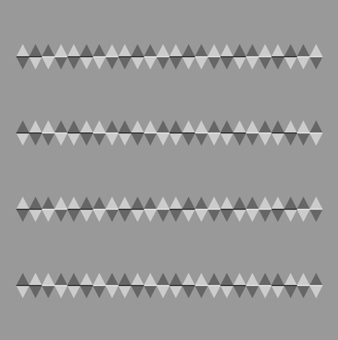
The horizontally aligned border of the uppermost row appear to tilt counterclockwise, and the other borders appear to tilt alternately.
The 4-stroke motion of the asymmetric line type
The border appears to move upward.
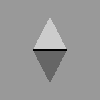
(GIF animation)

The movie shows elements in the order 123412341234...
Copyright Akiyoshi Kitaoka 2012 (December 5)
illusion of striped cords
The horizontal black-and-white line appears to tilt counterclockwise (Kitaoka,
1998; Kitaoka et al., 2004).

Kitaoka, A. (1998). Apparent contraction of edge angles. Perception, 27, 1209-1219.
Kitaoka, A., Pinna, B., and Brelstaff, G. (2004). Contrast polarities determine the direction of Café Wall tilts. Perception, 33, 11-20.
The 4-stroke tilt illusion of the asymmetric edge type
(a variation of the illusion of striped cords or a variation of the illusion
of shifted edges)

The horizontally aligned border of the upper and lower halves appears to
tilt counterclockwise.
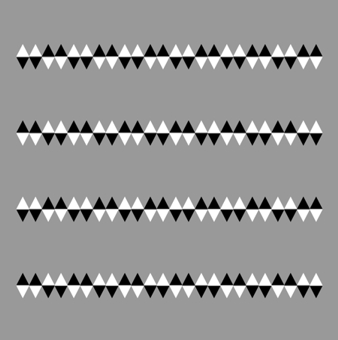
The horizontally aligned border of the uppermost row appear to tilt counterclockwise, and the other borders appear to tilt alternately.
The 4-stroke motion of the asymmetric edge type
The border appears to move upward.
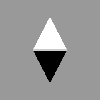
(GIF animation)

The movie shows elements in the order 123412341234...
Copyright Akiyoshi Kitaoka 2012 (December 5)
a variation of the illusion of striped cords (illusion of striped edges)
The horizontal border appears to tilt counterclockwise (Kitaoka, 2007;
; Kitaoka et al., 2004).

Kitaoka, A. (2007) Tilt illusions after Oyama (1960): A review. Japanese Psychological Research, 49, 7-19. PDF
Kitaoka, A., Pinna, B., and Brelstaff, G. (2004). Contrast polarities determine the direction of Café Wall tilts. Perception, 33, 11-20.
The multi-stroke tilt illusion of the asymmetric line type
(Montalvo illusion = Lavatory Wall illusion)

The horizontally aligned border of the upper and lower halves appears to
tilt counterclockwise.
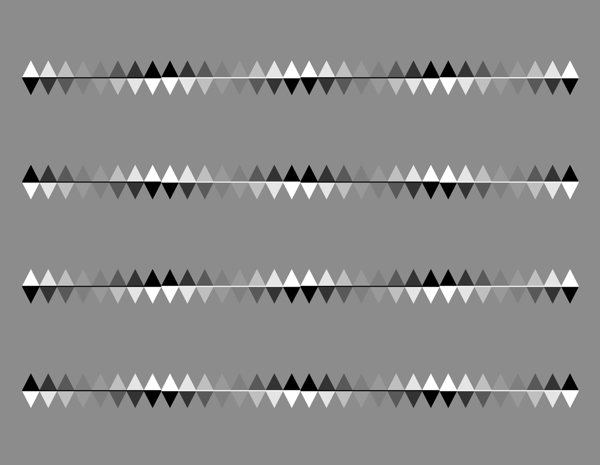
The horizontally aligned border of the uppermost row appear to tilt counterclockwise, and the other borders appear to tilt alternately.
The 4-stroke motion of the asymmetric edge type
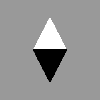
(GIF animation)

The movie shows elements in the order 123412341234...
Copyright Akiyoshi Kitaoka 2012 (December 5)
Montalvo illusion (Lavatory Wall illusion)
The horizontal line appears to tilt counterclockwise (Sakane 1980; Woodhouse
and Taylor 1987). This illusion was first presented by Fanya S. Montalvo
in 1980 (Sakane 1980) and was independently reported by Woodhouse and Taylor
(1987) who termed it 'Lavatory Wall illusion'. Also see Kitaoka et al.
(2004) and Kitaoka (2007).

Kitaoka, A. (2007) Tilt illusions after Oyama (1960): A review. Japanese Psychological Research, 49, 7-19. PDF
Kitaoka, A., Pinna, B., and Brelstaff, G. (2004). Contrast polarities determine the direction of Café Wall tilts. Perception, 33, 11-20.
Sakane I, 1980 Shin Asobino Hakubutsushi (A New Museum of Fun Book) Part II Tokyo: Asahi-bunko (pp. 156-165) (in Japanese).
Woodhouse J M, Taylor, S P, 1987 “Further studies of the Café Wall and Hollow Squares illusions” Perception 16 467-471
First presented by Fanya S. Montalvo in 1980 (Sakane 1980) it has since been termed the Lavatory Wall illusion (Woodhouse and Taylor 1987).